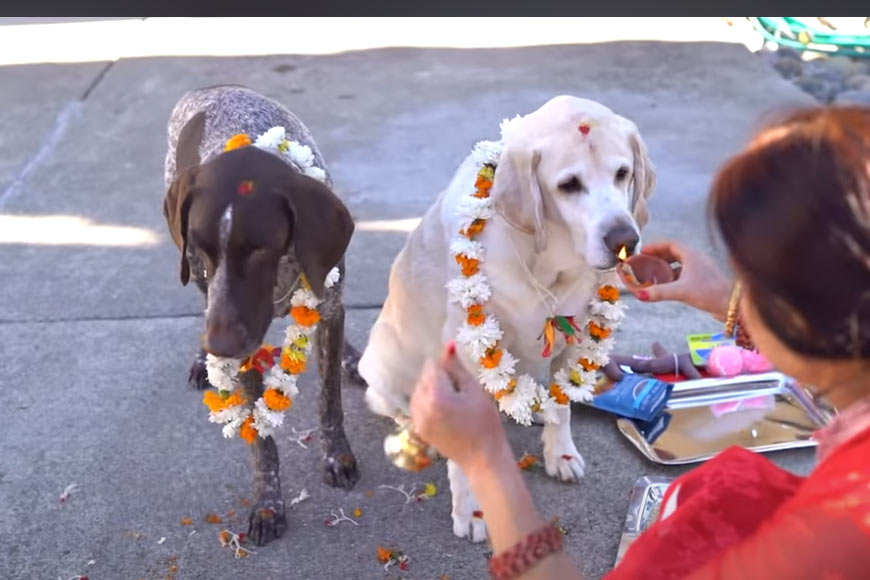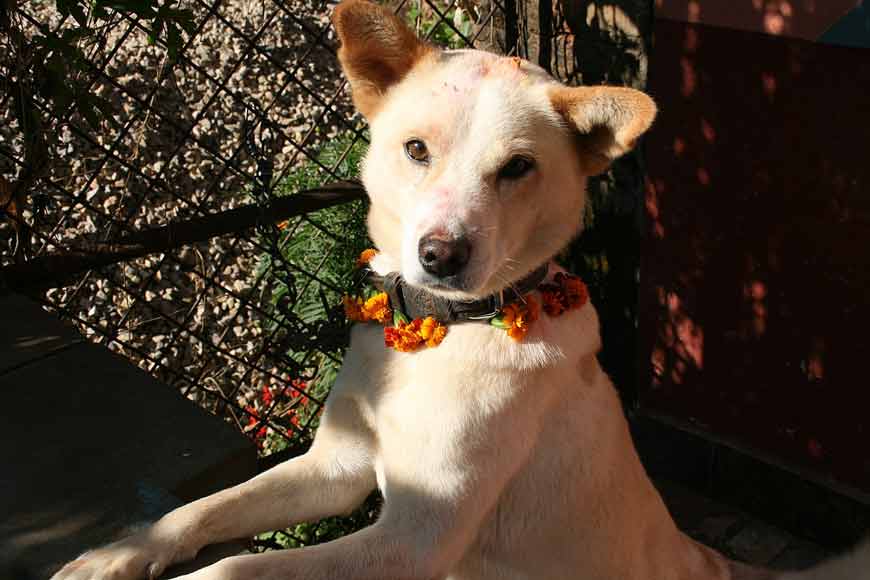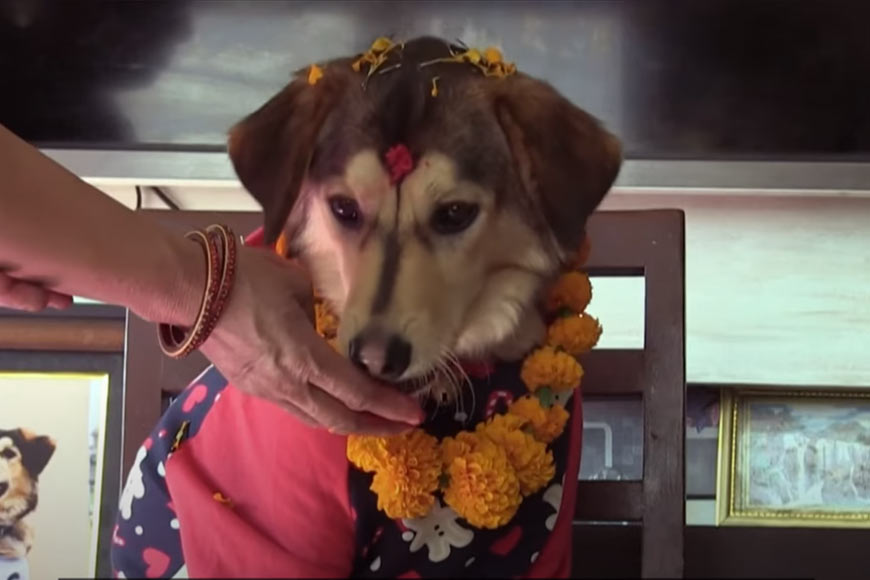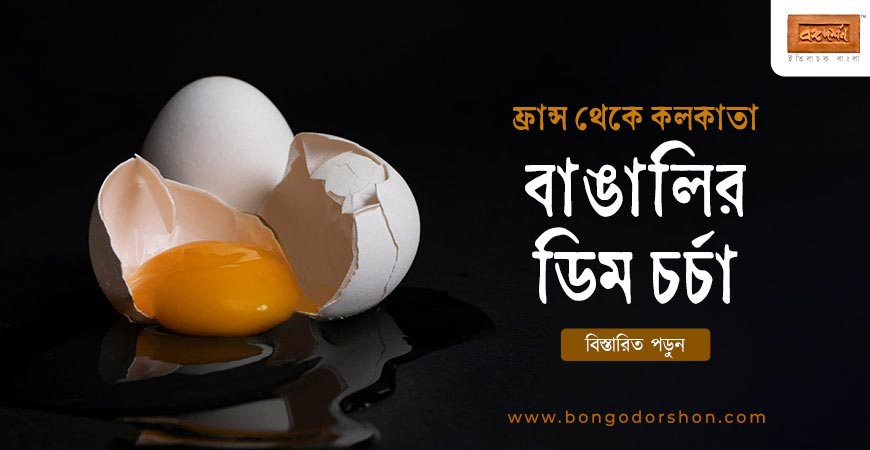Kukur Tihar – celebrating the existence of man’s best friend - GetBengal story

Kukur Tihar, a Nepalese Hindu festival for canines
The unity in diversity – a key ecological principle – is also the very basis of India’s nationhood and the uniting principle of Hinduism. The unique relation of Hinduism to nature, according to Dr Nandita Krishna, author of ‘Hinduism and Nature’ comes from the Vedic creation hymns, which despite their pluralism; emphasize the non-dual nature of the creator and the creation. The concepts of dharma and karma emerge as important guiding principles in determining the relation of Hindu community to nature not only through the overarching worldview but also through daily rituals and activities.
According to legend, when Lord Brahma created animals, he hid a specific secret in each of them to signify their spiritual importance to humans and hence Hindus believe divinity resides in all living creatures, such as a deity incarnate, and then lives on earth among human beings. Therefore, reverence and respect for animals, form an integral part of religion and various animals are venerated as representatives of divinity.
The Hindus in Nepal and in some parts of India, especially in the northeast region of Sikkim and Gorkhaland (particularly in the towns of Darjeeling and Kalimpong, which host a large number of ethnic Indian Gorkha population) worship dogs as part of a five-day Tihar (also known as Khicha Puja, Deepawali and Yamapanchak) that falls roughly in November annually. Tihar is analogous to the Indian festival of Diwali, the festival of lights, but with some significant differences.

According to legend, the dog is a messenger of Yama, the god of death, and they guard the doors of Hell. Sarama is considered the mother of all dogs. Dogs are also worshipped as the vehicle of Kal-Bhairava, the "terribly fearsome form" of Lord Shiva who destroys fear and is beyond fear. Dogs are also man’s best friend, companion, and protectors of human homes and lives. Therefore, to appease dogs, the 14th day of the lunar cycle in November is marked as Kukur Tihar or, as known in the Nepali language for the dog's day.
As with Diwali, Tihar is marked by lighting ‘diyo’ (earthen lamps) inside and outside homes but unlike the Indian festival, the five days of Tihar include celebration and worship of the four creatures associated with the Hindu god of death, Yama, with the final day reserved for people themselves. According to the Vikram Samvat calendar, the festival begins with Kaag (crow) Tihar on Trayodashi tithi of Kārtika kṛiṣṇa pakṣa (the 13th day of the waning moon) and ends with Bhai Tika on Dwitiya tithi of Kārtika śukla pakṣa every year. Crows and ravens, believed to be the messengers of Yama, are worshipped with offerings of grains, seeds, and sweets placed on the roofs or out on the streets. By feeding the crows, devotees hope to appease them and ward off death and grief for the coming year. Alongside Kaag Tihar, Dhanteras (also known as Dhan Trayodashi and Dhanwantari Jayanti) is also observed on this day.
Day 2 is Kukur Tihar — dog day! On this day, all dogs, whether pets or strays, are offered treats and worshipped by placing a tika on their forehead and garlands of marigolds around their necks. This day celebrates the special relationship between humans and dogs. At the gates of Heaven (Swarga), Yudhishthira refuses to enter without the dog, who reveals himself to be the god Yama. Thus, the ancient bond between man and dog is established in the Mahabharata. Kala Bhairava, a fierce manifestation of Lord Shiva, with his vahana (vehicle), a dog, is also mentioned in the Mahabharata. Yama is believed to own two guard dogs – each with four eyes. The dogs are said to watch over the gates of Naraka, the Hindu concept of Hell. Owing to this belief, this day is also observed as Naraka Chaturdashi.
Kukur Tihar has acquired widespread popularity on the internet and in 2016, was even adopted by a Mexican animal rights group for a similar celebration in Mexico City. This year, animal lovers celebrated "Kukur Tihar" or Kukur Puja festival at a street dog rescue centre in Siliguri with great enthusiasm. Animal Helpline, a renowned animal lovers’ organization of Siliguri celebrated the day with great zeal. In the morning, members of the voluntary organization bathed around a hundred stray dogs rescued from the streets and worshipped them. They also cooked special meals for their furry friends and hosted a sumptuous spread for them.
Priya Rudra, founder of Animal Helpline, Siliguri, wanted to host something very special for the inmates of her shelter. Dogs provide emotional support when we are stressed or anxious and are highly attentive to our emotional states. They have also been found to reduce levels of the stress hormone cortisol, lower perceived stress in individuals, improve mood, and energy up to 10 hours after interactions. They have been found to reduce subjective pain, increase good hormones and dampen bad ones, causing some patients to require less pain medications.

Kukur Tihar is gaining popularity among animal lovers and organizing the festival in a community as Rudra did, helps in sensitizing the masses to be more sympathetic towards the co-inhabitants of the land. A day like Kukur Tihar is a reminder for all of us that animals are an important and integral part of our society. People should love, trust and respect this bonding. During festivals like Diwali, when people go all out to burst crackers they do not realize how disturbing the sound gets for animals but if mass participation is encouraged during Kukur Tihar, people will possibly be more sensitive and spare street dogs from pain and agony.
The morning of the third day is called Gai (cow) Tihar. The cow is an especially important animal in Hinduism and is considered sacred. Devotees show their gratitude to the cow by feeding them treats and worshipping them with tikas and garlands. The fourth day of Tihar is known as as Goru puja, where the ox is worshipped and celebrated. The ox is seen as an analogue to the cow in Hinduism, as the ox provides manual labour, important for an agricultural country. The fifth and last day of Tihar is called Bhai Tika. On this final day, which is celebrated with much fanfare across the country, brothers and sisters mark their special bond by worshipping each other.











